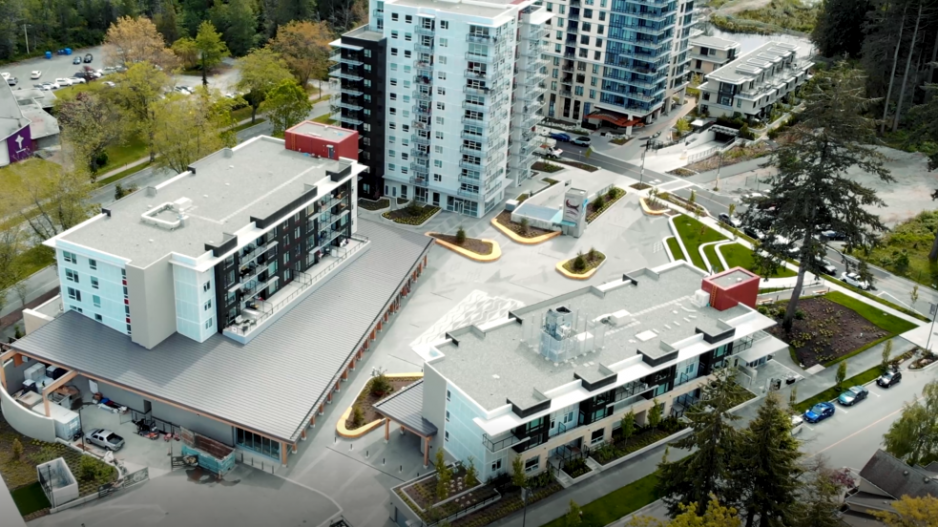The Lower Mainland is in the midst of an Indigenous real estate renaissance, says Dennis Thomas Whonoak, senior business development manager with the Tsleil-Waututh Nation.
A growing number of First Nations-led development projects are in progress or in the pipeline throughout the region. They will not only bring online more housing supply, but they are reshaping real estate processes, and offer an opportunity for reconciliation on stolen lands.
For example, the Musqueam Indian Band, Squamish Nation and Tsleil-Waututh Nation have joined forces to buy back lands that were taken from them, Thomas Whonoak said.
“With the power of the three nations coming together, it really shows unity. It shows our kinship, it shows our cultural values for long-term generational wealth,” he said. “Compared to Western processes of acquiring land, building it and then selling it … we’re buying it, building and keeping it in perpetuity.”
According to Stephen Lee, CEO of Musqueam Capital Corp., the three First Nations have upcoming projects that will shape the landscape of the Lower Mainland.
“I think with the awareness of reconciliation and the current environment that we’re in, it presents a very favourable environment for us to continue our long term views in terms of our real estate projects, as well as upcoming investments,” said Lee.
Since 2014, the three nations have been working together through MST Development Corp. Through this partnership, they are full or co-owners of six properties in Metro Vancouver that have more than 160 acres of developable land and are valued at over $1 billion. This does not include the individual real estate ventures of each nation.
“We have been identified as the largest private landowner and the most powerful group in Vancouver when it comes to private lands and real estate,” said Thomas Whonoak.
Within the last year, he said that progress has been made on rezoning enactment and marketing. The lands owned by MST Development are designated as fee-simple lands, meaning that there are guidelines and a development process that need to be followed.
The Tsleil-Waututh Nation has been working in real estate and development for the past 30 years, according to Matthew Thomas, part of the leadership of MST Development and the economic development officer and vice-president of Takaya Developments. He says that there has been positive support from outside groups who are accepting of First Nations-led developments, and recognize how communities can partner with the First Nations to “help one another out.”
Lee said that when it comes time to consider a development project, land costs are the biggest hurdle to making a project viable. The current interest rate environment means the MST Development nations are being more cautious when it comes to planning projects.
Local and provincial government funding programs, such as the BC Housing Indigenous Housing Fund and Canada Mortgage and Housing Corp.’s rental housing programs, are available to offset some of these costs. Forging partnerships with local developers can also help, according to Isthmus Capital, a joint-venture partner to the nations on development projects.
MST Development is currently working on a project called Heather Lands, which accounts for 21 acres of land between West 33rd Ave. and West 37th Ave. at Heather Street, according to the City of Vancouver.
Thomas Whonoak said the project is unique in its use of cultural liaisons, who worked with planners and architects to Indigenize the property.
“That’s a special thing about all of our projects is we are literally changing the Western development process, to have eyes that see our world views, how we would want a development to look and feel like,” he said.
MST Development is also working on the Jericho Land projects. It is currently the largest parcel of land owned by the three nations and accounts for 92 acres, according to Thomas Whonoak.
“It’s a very special site to all three nations and just north of it, along the beachfront, there used to be a village site that was occupied intensely throughout all seasons of the year by the three nations. It was a gathering location where a lot of trade and bartering and connections, marriages and celebrations all happened. It was also a meeting point for outside communities that wanted to trade and so for us to retain something very close and special to our hearts is something that was a success for our nations,” he said.
The Musqueam Nation is also working on a current project called lelem, which is situated on the western edge of Pacific Spirit Park on the University Endowment Lands, according to Lee. The project is one-third of the way to completion, he said, and will feature multi-family living and retail spaces.
Musqueam’s master-planned community on the nation’s main reserve land is also in its latter stages, said Lee, who described the nation’s current project pipeline as “healthy.”
The key to many of these developments is collaboration with local and provincial governments, and cooperation among nations, according to the individuals who spoke to Glacier Media.
“Now that the power of the three nations came together, and owning as much property that we do, we’re literally in an Indigenous renaissance. We’re not only owners of the land, we want to build it as well, with partners, entrepreneurs, with band businesses and other Indigenous businesses, to hopefully say one day that this was built 60, 70, 80, 90 – 100 per cent by Indigenous Peoples,” said Thomas Whonoak.
This article was first published in BIV's print edition. For first access to print content, become a BIV subscriber.



